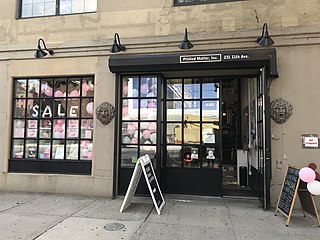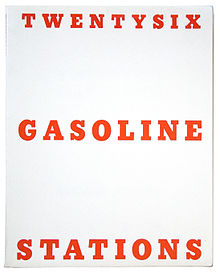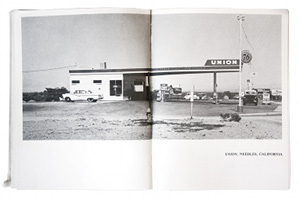
Morris "Mort" Drucker was an American caricaturist and comics artist best known as a contributor for over five decades in Mad, where he specialized in satires on the leading feature films and television series.

Artists' books are works of art that utilize the form of the book. They are often published in small editions, though they are sometimes produced as one-of-a-kind objects.

Edward Joseph Ruscha IV is an American artist associated with the pop art movement. He has worked in the media of painting, printmaking, drawing, photography and film. He is also noted for creating several artist's books. Ruscha lives and works in Culver City, California.

Kiki Smith is a West German-born American artist whose work has addressed the themes of sex, birth and regeneration. Her figurative work of the late 1980s and early 1990s confronted subjects such as AIDS, feminism and gender, while recent works have depicted the human condition in relationship to nature. Smith lives and works in the Lower East Side, New York City, and the Hudson Valley, New York State.

Allen Ruppersberg is an American conceptual artist based in Los Angeles and New York City.

Warja Lavater was born in Winterthur, Switzerland. She was a Swiss artist and illustrator noted primarily for working in the artist's books genre by creating accordion fold books that re-tell classic fairy tales with symbols rather than words.
Petrus Graf Schaesberg was a German art historian, artist, editor, and teacher.
Eric Doeringer is an artist currently living and working in Brooklyn, New York. He graduated from Brown University in 1996 with a B.A. and received an MFA from the School of the Museum of Fine Arts, Boston in 1999. Doeringer is on the faculty at Manhattan's School of Visual Arts.
Parkett was an international magazine specializing in art. The magazine ceased publication in Summer 2017 with its 100th issue and now continues online as a time capsule and archive with some 270 in-depth artists portraits, artists documents, newsletters and more at www.parkettart.com.
Robert Rooney (1937–2017) was an artist and art critic from Melbourne, Australia, and a leading figure in Australian Conceptual art.

Peter Plagens is an American artist, art critic, and novelist based in New York City. He is most widely known for his longstanding contributions to Artforum and Newsweek, and for what critics have called a remarkably consistent, five-decade-long body of abstract formalist painting. Plagens has written three books on art, Bruce Nauman: The True Artist (2014), Moonlight Blues: An Artist's Art Criticism (1986) and Sunshine Muse: Modern Art on the West Coast, 1945-70 (1974), and two novels, The Art Critic (2008) and Time for Robo (1999). He has been awarded major fellowships for both his painting and his writing. Plagens's work has been featured in surveys at the Museum of Modern Art, Los Angeles County Museum of Art (LACMA), Whitney Museum, and PS1, and in solo exhibitions at the Hirshhorn Museum and Las Vegas Art Museum. In 2004, the USC Fisher Gallery organized and held a 30-year traveling retrospective of his work. Critics have contrasted the purely visual dialogue his art creates—often generating more questions than answers—with the directness of his writing; they also contend that the visibility of his bylines as a critic has sometimes overshadowed his artmaking—unduly. Los Angeles Times critic David Pagel described Plagens's painting as a "fusion of high-flying refinement and everyday awkwardness" with an intellectual savvy, disdain for snobbery and ungainliness he likened to Willem de Kooning's work. Reviewing Plagens's 2018 exhibition, New York Times critic Roberta Smith called the show an "eye-teasing sandwich of contrasting formalist strategies," the hard-won result of a decade of focused experimentation.
Keith A. Smith is an American artist and author. He has taught at the Visual Studies Workshop, the School of the Art Institute of Chicago, and the University of Illinois. He is a recipient of two Guggenheim Fellowships, a National Endowment of the Arts grant and a Pollock-Krasner Foundation grant. Smith creates books as works of art, as well as instructional texts on how to make books. Permanent collections which hold works by Smith include the National Gallery of Art, Museum of Modern Art, the National Gallery of Canada, and the Center for Creative Photography.
Siri Engberg is curator of visual arts at the Walker Art Center in Minneapolis, Minnesota. She wrote or edited a number of catalogues raisonnés, often with the artist's participation. Engberg organized about a half dozen shows before becoming assistant and then curator, which allowed her to curate several large touring shows and other major exhibitions.
Jeff Brouws is a documentary photographer who resides in Upstate New York.

Printed Matter, Inc. is an independent 501(c)(3) non-profit grant-supported bookstore, artist organization, and arts space which publishes and distributes artists' books. It is currently located at 231 11th Avenue in the Chelsea neighborhood of New York City.
David Campany is a British writer, curator, artist and educator, working mainly with photography. He has written and edited books; contributed essays and reviews to other books, journals, magazines and websites; curated photography exhibitions; given public lectures, talks and conference papers; had exhibitions of his own work; and been a jury member for photography awards. He has taught photographic theory and practice at the University of Westminster, London. Campany is Managing Director of Programs at the International Center of Photography in New York City.

Clive Phillpot is a specialist on artists' books, essayist, art writer, curator, and a librarian. Phillpot started his library career at the Charing Cross Public Library in London.

Paul Soulellis is an American graphic designer, artist, and educator. His writings and work in the field of experimental publishing and network culture are cited in influential scholarly research. His publications are collected and exhibited worldwide and on the internet. He works in New York City and Providence, Rhode Island.











